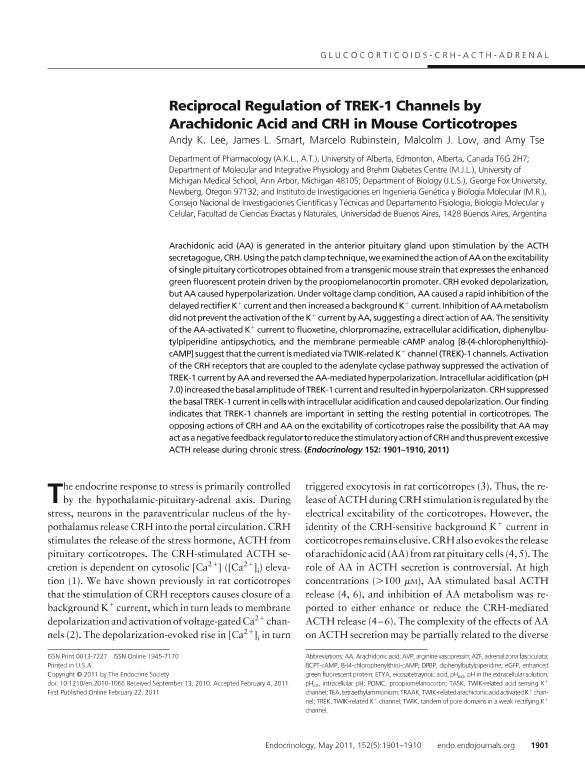Mostrar el registro sencillo del ítem
dc.contributor.author
Lee, Andy K.
dc.contributor.author
Smart, James L.
dc.contributor.author
Rubinstein, Marcelo

dc.contributor.author
Low, Malcolm J.

dc.contributor.author
Tse, Amy
dc.date.available
2019-07-11T21:12:38Z
dc.date.issued
2011-05
dc.identifier.citation
Lee, Andy K.; Smart, James L.; Rubinstein, Marcelo; Low, Malcolm J.; Tse, Amy; Reciprocal regulation of TREK-1 channels by arachidonic acid and CRH in mouse corticotropes; Endocrine Society; Endocrinology; 152; 5; 5-2011; 1901-1910
dc.identifier.issn
0013-7227
dc.identifier.uri
http://hdl.handle.net/11336/79445
dc.description.abstract
Arachidonic acid (AA) is generated in the anterior pituitary gland upon stimulation by the ACTH secretagogue, CRH. Using the patch clamp technique, we examined the action of AA on the excitability of single pituitary corticotropes obtained from a transgenic mouse strain that expresses the enhanced green fluorescent protein driven by the proopiomelanocortin promoter. CRH evoked depolarization, but AA caused hyperpolarization. Under voltage clamp condition, AA caused a rapid inhibition of the delayed rectifier K+ current and then increased a background K+ current. Inhibition of AA metabolism did not prevent the activation of the K+ current by AA, suggesting a direct action of AA. The sensitivity of the AA-activated K+ current to fluoxetine, chlorpromazine, extracellular acidification, diphenylbutylpiperidine antipsychotics, and the membrane permeable cAMP analog [8-(4-chlorophenylthio)-cAMP] suggest that the current is mediated via TWIK-related K+ channel (TREK)-1 channels. Activation of the CRH receptors that are coupled to the adenylate cyclase pathway suppressed the activation of TREK-1 current by AA and reversed the AA-mediated hyperpolarization. Intracellular acidification (pH 7.0) increased the basal amplitude of TREK-1 current and resulted in hyperpolarizaton. CRH suppressed the basal TREK-1 current in cells with intracellular acidification and caused depolarization. Our finding indicates that TREK-1 channels are important in setting the resting potential in corticotropes. The opposing actions of CRH and AA on the excitability of corticotropes raise the possibility that AA may act as a negative feedback regulator to reduce the stimulatory action of CRH and thus prevent excessive ACTH release during chronic stress.
dc.format
application/pdf
dc.language.iso
eng
dc.publisher
Endocrine Society

dc.rights
info:eu-repo/semantics/openAccess
dc.rights.uri
https://creativecommons.org/licenses/by-nc-sa/2.5/ar/
dc.subject
Hipófisis
dc.subject.classification
Bioquímica y Biología Molecular

dc.subject.classification
Ciencias Biológicas

dc.subject.classification
CIENCIAS NATURALES Y EXACTAS

dc.title
Reciprocal regulation of TREK-1 channels by arachidonic acid and CRH in mouse corticotropes
dc.type
info:eu-repo/semantics/article
dc.type
info:ar-repo/semantics/artículo
dc.type
info:eu-repo/semantics/publishedVersion
dc.date.updated
2019-07-10T19:04:36Z
dc.journal.volume
152
dc.journal.number
5
dc.journal.pagination
1901-1910
dc.journal.pais
Estados Unidos

dc.journal.ciudad
Los Angeles
dc.description.fil
Fil: Lee, Andy K.. University of Alberta; Canadá
dc.description.fil
Fil: Smart, James L.. George Fox University; Estados Unidos
dc.description.fil
Fil: Rubinstein, Marcelo. Consejo Nacional de Investigaciones Científicas y Técnicas. Instituto de Investigaciones en Ingeniería Genética y Biología Molecular "Dr. Héctor N. Torres"; Argentina
dc.description.fil
Fil: Low, Malcolm J.. University of Michigan Medical School; Estados Unidos
dc.description.fil
Fil: Tse, Amy. University of Alberta; Canadá
dc.journal.title
Endocrinology

dc.relation.alternativeid
info:eu-repo/semantics/altIdentifier/doi/https://dx.doi.org/10.1210/en.2010-1066
dc.relation.alternativeid
info:eu-repo/semantics/altIdentifier/url/https://academic.oup.com/endo/article/152/5/1901/2457107
Archivos asociados
